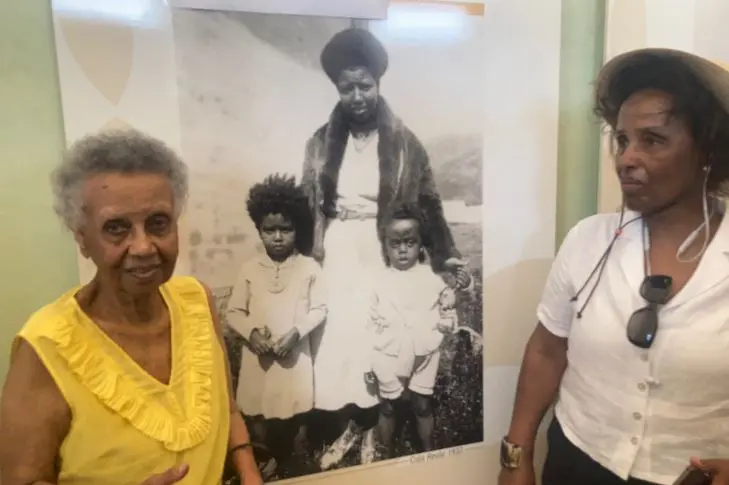Ethiopians deported to Asinara, Yeweinshet returned to the island after 88 years.
The only direct witness of a dramatic period in Ethiopian-Italian historyPer restare aggiornato entra nel nostro canale Whatsapp
"It was emotional to return here to the island of Asinara; I appreciated the warm welcome. I'm not as clear-minded as I once was, but I remember that this place was full of prisoners back then, with Ethiopian women and children living in a single house, with only one point of contact where we could get food."
In the eyes of Yeweinshet Beshah-Woured, now 94 years old, the only direct witness to a dramatic period in Ethiopian-Italian history , one can read the desire to return to the place where she lived for several months, together with the approximately three hundred people deported from Ethiopia when she was only six years old.
He did so almost ninety years later, along with 60 other descendants of exiled Ethiopians, to share a moment of remembrance. They saw firsthand an island that holds a place for them, traces of the stories of deportation of a people repressed by the Royal Italian Army and, from 1937 to 1939, partly exiled to Asinara during the period in which Italy and its dictatorial regime pursued the goal of establishing a colonial future in the Horn of Africa. The aftermath of a tragedy recounted over the four-day event organized between Porto Torres and Asinara from August 5th to 8th, an initiative of great cultural value that reopened a sad page in history, lest we forget.
The project, titled "From Oblivion to Memory. The History of Ethiopian Deportees to Asinara 1937-39," is the result of meticulous research by the Sealand Asinara cooperative, an idea born in collaboration with the Asinara National Park, the Municipality of Porto Torres, the Association of Exclusive Guides of Asinara (A.Gu.A.) chaired by Paola Fontecchio, and the Educando Asinara Network.
"I felt safe because my mother, who was pregnant at the time, and my four-year-old brother were close by. I don't have any bad memories, but I do remember that they later transferred us to Rome," adds Yeweinshet Beshah-Woured, deported to Asinara after her father was killed in the Addis Ababa massacre. Ministers, magistrates, soldiers, ambassadors, and members of the Ethiopian elite and ruling class were deported to the island between March 1937 and July 1939, after the assassination attempt in Addis Ababa against the viceroy of Ethiopia, Rodolfo Graziani.
An attack carried out in the late morning of February 19 and 21, 1937, by two young Eritrean partisans who threw hand grenades at the fascist authorities, present at a ceremony in the Guennet Leul palace.
The reaction was a violent reprisal, a real massacre of the Ethiopian population, with thousands of victims and the confinement of all those believed to be the perpetrators of the attack .
Some of them, as many as 291 prominent figures of the deposed Emperor Haile Selassie, were confined to the Asinara collection and preparation camp. Men, women, and children torn from their homeland and forced to live in isolation, deprived of any possibility of return. These pieces of history were told during the conference, August 5th, which featured Elfy Getachew Nouvellon, known for her invaluable work as an archivist, which allowed her to reconstruct the family tree and reunite the descendants of the Ethiopian deportees, who had come for the occasion from all over the world, from Australia, the United States, Canada, but also from Germany and France. Elfy's children, Sarah and Menelik Nouvellon, were also present.
"My mother tried to reconstruct the family history through an article published in an online newspaper, which traced the passage of Ethiopians to Asinara," Sarah explains, "and from there the great research began. It was discovered that Elfy is the great-granddaughter of Haile Wolde Meskel, son of Tsehafi Tehezaz Wolde Meskel Tariku, a prominent Ethiopian statesman who served as minister under several emperors."
Haile was deported to Asinara in 1937, along with his father and brother Maheteme Selassie. Deeply affected by the long journey and harsh conditions of detention, he died a few months later, in September 1937, at the Sassari hospital and was buried in the city cemetery. The conference was attended by Valeria Deplano and Alessandro Pes of the University of Cagliari, as well as Andrea Giuseppini, editor of the website campifascisti.it. The commissioner and director of the park, Gianluca Mureddu, and Vittorio Gazale also spoke.
The next day on the island (August 6), a plaque in memory of the deportees was placed in Cala Reale, in what was once the infectious diseases hospital , followed by traditional Ethiopian prayers. A visit was also made to the Campo Faro cemetery, where the son Gedeon of Princess Romane Work, the eldest daughter of the Emperor of Ethiopia, Haile Selassie, who was kidnapped by Mussolini and confined to the island, was buried.
The project, conceived by Paola Fontecchio, included a visit by an Ethiopian delegation to Mayor Massimo Mulas, followed by a well-attended conference in the Filippo Canu Hall (August 7), featuring firsthand accounts from descendants of Ethiopian deportees. It was also an opportunity to reconnect with Gianfranco Massidda, a former lighthouse keeper on the island, now 92. The evening of August 8 concluded with a performance by Italian-Ethiopian artist Gabriella Ghermandi.
